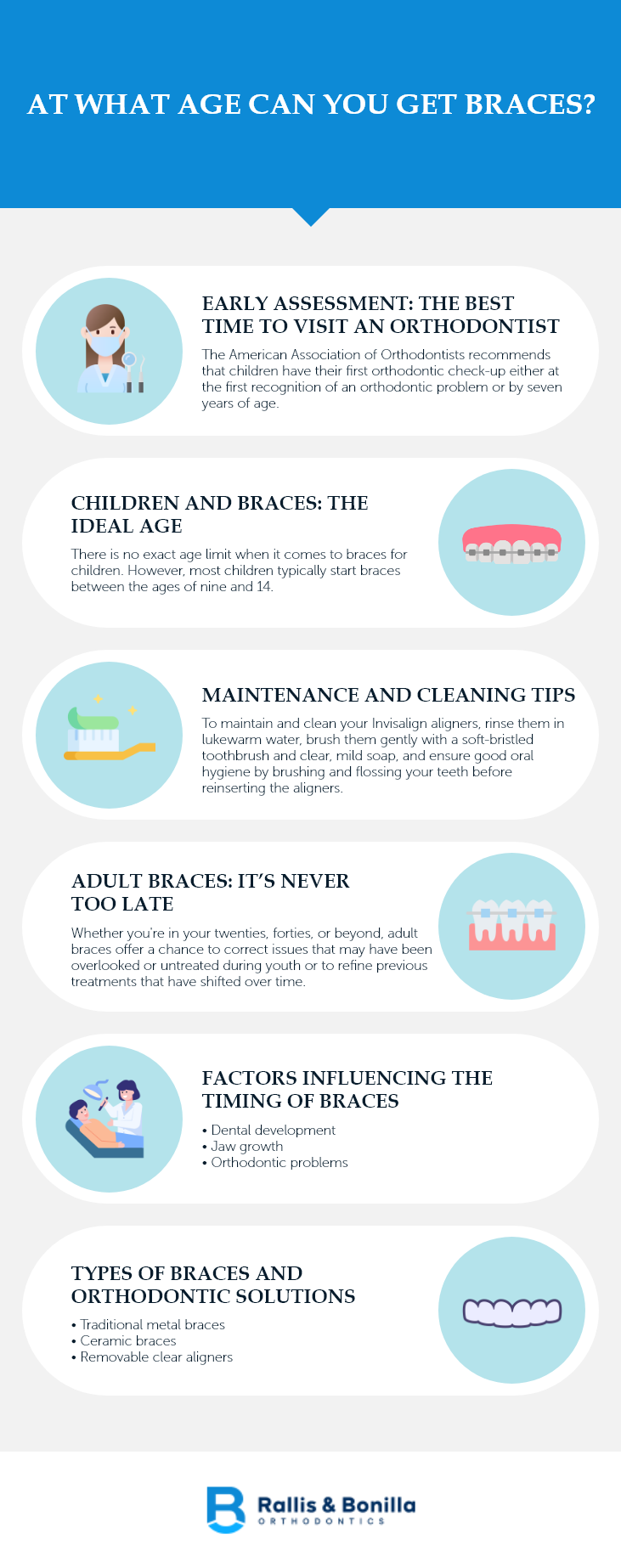Deciding when to get braces is a common dilemma many individuals and families face when considering orthodontic treatment. This guide is designed to walk you through the various stages of life at which braces can be most effective, from the early years when the jaw is still developing to the teenage rush of growth and even into adulthood, where it’s never too late to achieve the smile you’ve always wanted. Our goal is to assist you with insights into the best times for orthodontic treatment and to dispel any myths that may have held you back. Whether for yourself or your loved ones, understanding the best time to begin this journey can lead to not just a more beautiful smile but a healthier one too.
Understanding Orthodontic Treatment
Orthodontic treatment is all about creating healthy, beautiful smiles by aligning the teeth and jaws effectively. Braces, which are the most common type of orthodontic treatment, consist of bands, wires, and other fixed or removable corrective appliances that gently apply pressure to the teeth. This pressure gradually moves the teeth into the right position over time. The goal of orthodontic treatment goes beyond just improving how your smile looks; it also enhances oral health. Properly aligned teeth are easier to clean, which helps prevent cavities and gum disease and can alleviate or prevent discomfort from bite issues.
Orthodontic treatment isn’t a one-size-fits-all solution; it’s highly personalized. We design a treatment plan tailored specifically to your unique needs and goals. This plan considers several factors, including the current position of your teeth, the health of your gums and supporting bone, and your desired outcome.
Whether you’re considering braces for yourself or a family member, the journey to a straighter smile is a partnership between you and your orthodontist. Together, you’ll explore the various treatment options available, from traditional metal braces to clear aligners like Invisalign, and decide on the best course of action.
Early Assessment: The Best Time to Visit an Orthodontist
An early assessment by an orthodontist is a crucial step in ensuring your child’s oral health and development are on the right track. The American Association of Orthodontists (AAO) recommends that children have their first orthodontic check-up either at the first recognition of an orthodontic problem or by seven years of age. This might seem early, but at this age, we can spot issues with jaw growth and emerging teeth while some baby teeth are still present. Early detection allows for timely intervention, which can simplify later treatments or sometimes eliminate the need for them altogether.
This initial visit is more about evaluation than immediate action. We can identify potential problems such as crowding, overbites, underbites, and other alignment issues. In some cases, early treatment might not be necessary, and the orthodontist might simply monitor your child’s growth patterns until the time is right for treatment. However, if early intervention is needed, it can provide significant benefits:
- Guiding Jaw Growth – Early treatment can help guide the growth of the jaw and ensure that there’s enough space for permanent teeth to emerge correctly.
- Correcting Bad Habits – Issues like prolonged thumb sucking or pacifier use can be addressed.
- Improving Appearance and Self-Esteem – Early correction of dental issues can boost a child’s confidence.
- Reducing Risk of Damage to Protruding Teeth – Protruding front teeth are more susceptible to injury; early treatment can help protect them.
An early visit doesn’t necessarily mean your child will get braces right away. It’s a proactive approach to assess, monitor, and plan for your child’s dental health, ensuring any necessary orthodontic work is done at the ideal time for the best possible results.
Children and Braces: The Ideal Age
When it comes to children and braces, the “ideal” age can vary based on individual needs and developmental stages. There is no exact age limit when it comes to braces for children. However, most children typically start braces between the ages of nine and 14. During these years, children typically have a mix of baby teeth and adult teeth (permanent teeth), making it an opportune time to address orthodontic issues.
This period is ideal for orthodontic treatment because a child’s jaw is still growing, which can make certain corrections more manageable and less invasive than they would be for an adult. Treatment during these years can guide the proper growth of jawbones and incoming permanent teeth.
Parents should take into consideration:
- Timing is Key – The best time to start treatment varies. We can advise you on the optimal timing after a comprehensive orthodontic evaluation of your child’s teeth, jaw, and facial structure.
- Customized Treatment Plans – Each child’s orthodontic needs are unique. Treatment plans are tailored to individual requirements, whether it’s traditional metal braces, clear braces, or other orthodontic appliances.
- Patience and Support – Orthodontic treatment is a journey. Family support and encouragement play a crucial role in a child’s experience and adherence to treatment guidelines.
Starting orthodontic treatment at the right age for your child can have lasting benefits for their dental health and overall well-being. An early visit to our office can provide valuable insights into your child’s oral development, allowing for timely interventions that pave the way for a healthy, beautiful smile.
Adult Braces: It’s Never Too Late
Gone are the days when braces were only a rite of passage for teenagers. Today, more and more adults are deciding to embrace orthodontic treatment, and it’s clear why: it’s never too late to improve your smile. Whether you’re in your twenties, forties, or beyond, adult braces offer a chance to correct issues that may have been overlooked or untreated during youth or to refine previous treatments that have shifted over time.
Modern orthodontics provides a variety of discreet options suitable for adult lifestyles, including clear ceramic braces and invisible aligners like Invisalign. These alternatives allow for treatment without the aesthetic concerns of traditional metal braces. While adult teeth may take slightly longer to adjust than children’s, the principles of effective treatment remain the same—consistency and care. Following our advice and maintaining good dental care are key.
Choosing to get braces as an adult is a commendable decision that will enhance your appearance and improve your dental health. With the advancements in orthodontic technology and a greater emphasis on aesthetic options, there’s never been a better time to explore how braces can transform your smile and life.
Factors Influencing the Timing of Braces
When it comes to orthodontic treatment, timing can make a big difference. Various factors can influence when it’s best to start braces, whether for children, teenagers, or adults. Understanding these factors can help ensure that you or your loved ones receive the most effective and efficient treatment possible. Here’s what to consider:
- Dental Development – One of the primary considerations is the stage of dental development. For children, it’s often ideal to wait until most of the permanent teeth have come in, typically around age nine to 14. This allows us to address issues related to alignment and spacing more effectively.
- Jaw Growth – The growth of the jaw is another critical factor. Early intervention can be beneficial if we identify potential problems with jaw growth in children. For adults, treatment options might include different approaches, as their jaws have stopped growing.
- Orthodontic Problems – Certain dental issues may necessitate earlier or later treatment. For instance, severe overcrowding, underbites, or overbites might require early intervention to guide jaw development and tooth position. On the other hand, minor dental misalignment may be addressed once the majority of growth has occurred.
- Oral Health – Good oral health is essential before starting orthodontic treatment. Issues like cavities, tooth decay, gum disease, or the need for dental extractions can affect the timing of braces. Ensuring these problems are addressed beforehand can lead to a smoother orthodontic process.
- Lifestyle and Commitment – The decision to get braces also depends on personal readiness and lifestyle. Orthodontic treatment requires a commitment to maintenance and care, including regular orthodontist visits, proper cleaning, and, in some cases, dietary changes. Ensuring you or your child are ready for this commitment can influence the timing of treatment.
- Emotional Readiness – Emotional readiness and confidence to undergo and complete orthodontic treatment are important, especially for children and teenagers. Being mentally prepared can help ensure cooperation throughout the process, leading to more effective treatment.
The best time to start braces varies from person to person and is influenced by a combination of factors. Consulting with your orthodontist is the best way to determine the optimal timing for treatment, ensuring that you or your child can achieve the best possible outcome.
Types of Braces and Orthodontic Solutions
Exploring the world of braces and orthodontic solutions reveals a range of options designed to cater to different needs, preferences, and lifestyles. Today, patients can choose from several types of braces, each offering unique benefits. Here’s a look at the most common options available:
- Traditional Metal Braces – These are the most recognized type of braces, consisting of high-quality stainless steel brackets attached to each tooth, connected by a thin wire. Modern metal braces are much smaller and less noticeable than earlier versions. They are highly effective for treating a wide range of orthodontic issues and are often the most economical option.
- Ceramic Braces – Ceramic braces work just like metal braces but are designed with clear or tooth-colored brackets, making them less visible on your teeth. They’re a popular choice for patients seeking a more discreet option. While they may be less noticeable, they require careful maintenance to prevent staining.
- Removable Clear Aligners (Invisalign) – Clear aligners are nearly invisible, smooth plastic trays that cover the teeth and gently move them into place over time. They offer the flexibility to eat and drink whatever you like and make oral hygiene easier since you can remove them to brush and floss. Clear aligners are suitable for treating mild to moderate orthodontic issues.
- Self-Ligating Braces – Self-ligating braces use brackets with a built-in mechanism to hold the wire, eliminating the need for elastic bands. This design can reduce the amount of pressure exerted on the teeth and potentially shorten treatment times. They’re available in metal or ceramic options.
Selecting the best type of braces depends on various factors, including the complexity of your orthodontic needs, lifestyle preferences, aesthetic concerns, and budget. It’s important to discuss all available options with your orthodontist, who can recommend the most suitable solution based on your individual case.
Ready to take the first step towards a beautiful, healthy smile? Rallis and Bonilla Orthodontics are here to guide you on your journey. With three convenient locations: North Star, 84th Street, and Yankee Hill, expert orthodontic care is closer than you think. Our team is dedicated to providing personalized solutions for all ages, ensuring that your treatment is as comfortable and effective as possible. Whether you’re considering traditional braces or exploring clear aligners, we’re here to offer the support and expertise you need. Don’t let another day pass without taking action for your smile. Contact Rallis and Bonilla Orthodontics today and discover why we’re the trusted choice for orthodontic services in your community. Your journey to a confident smile starts here!

